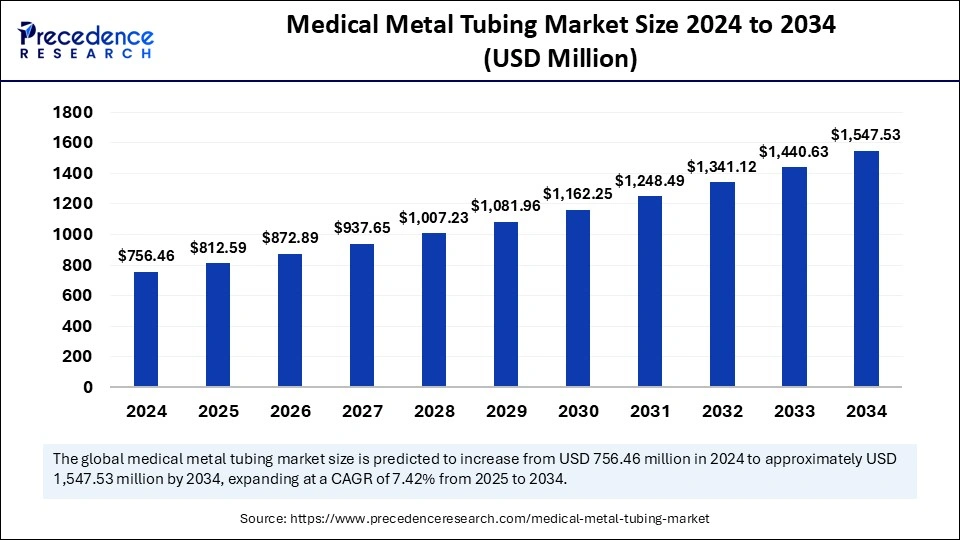
Medical Metal Tubing Market Key Takeaways
- North America dominated the global market with the largest share of 44% in 2024.
- Asia Pacific is projected to witness the fastest growth between 2025 and 2034.
- By material, the stainless steel segment led the market in 2024.
- By material, the titanium segment is expected to grow at the fastest CAGR in the coming years.
- By application, the dialysis or intravenous tubing segment contributed the biggest market share in 2024.
- By application, the drug delivery systems segment is likely to witness the fastest growth over the studied period.
- By end-user, the hospitals segment generated the major market share in 2024.
- By end-user, the ambulatory surgical centers segment is anticipated to expand at the fastest CAGR during the forecast period.
Medical Metal Tubing Market Overview
In the diagnostic and endoscopic sectors, the Medical Metal Tubing Market is evolving rapidly, driven by the growing demand for high-performance, miniaturized components. Metal tubing plays a vital role in the structural and functional design of endoscopes, biopsy tools, and other diagnostic instruments. These applications demand tubes with high torsional strength, kink resistance, and corrosion resistance, especially as devices are pushed deeper into the body and used in complex environments.
Drivers
The increasing adoption of non-invasive and semi-invasive diagnostic procedures is a major growth driver. Rising awareness and early screening practices for diseases such as gastrointestinal disorders and cancers have boosted demand for endoscopic technologies. In addition, improvements in diagnostic accuracy through high-definition imaging systems have created the need for better supporting materials, such as metal tubing, that can withstand repeated use without degradation.
Growing Aging Population
The growing geriatric population around the world is a major factor driving the growth of the medical metal tubing market. Geriatric people are more prone to chronic diseases, such as diabetes and cardiovascular diseases (CVDs), which often require medical devices made from metal tubing to manage these conditions.
Moreover, older adults often experience orthopedic conditions, such as osteoporosis and arthritis, that require medical intervention like surgeries. This, in turn, boosts the demand for implants that are made from metal tubing. The rising prevalence of chronic diseases among older adults further drives the market growth.
According to the research report published by the National Council on Aging (NCOA) in May 2024, about 95% of adults aged 60 and above have at least one chronic condition, while 80% have two or more.
Opportunities
Miniaturization is opening significant opportunities for innovation in metal tubing design and manufacturing. Tubes with micro-diameters are in high demand for advanced imaging and biopsy tools. Another promising area is the integration of sensors within tubing structures to enable real-time data collection during diagnostic procedures. The growing trend of ambulatory surgical centers and outpatient procedures also supports market expansion.
Demand for Small-diameter Stainless Steel Tubing and Technological Innovations
The increasing demand for small-diameter stainless steel medical metal tubing creates significant opportunities in the market, expanding the scope of applications in diagnostic and surgical instruments. Small-diameter stainless steel tubing finds applications in syringe needles, implantable device components, in vitro diagnostic probes, and marker bands for catheters and guidewires.
Advances in material properties and tube design are boosting the development of minimally invasive medical devices, enhancing patient outcomes while reducing technical trauma. Furthermore, innovations such as heat-exchange tubes for blood temperature regulation during surgery, microtools for precision surgical procedures, and stents are expanding the market opportunity.
Challenges
Maintaining the integrity and functionality of metal tubes in extremely small diameters can be technically challenging. The manufacturing process for micro-tubing is complex and requires significant capital investment in precision machinery. Moreover, these devices must undergo rigorous regulatory scrutiny to ensure patient safety, which can slow down market entry and increase costs for developers.
Regional Insights
Europe and North America are currently the leading markets due to their established diagnostic imaging networks and reimbursement structures. However, the Asia-Pacific region is rapidly catching up, especially with government initiatives aimed at improving diagnostic infrastructure in countries like Japan, South Korea, and India. Latin America and the Middle East are also emerging as potential markets as healthcare access continues to expand.
Recent Developments
Recent trends include the launch of metal tubing with anti-bacterial coatings to reduce infection risks during diagnostics. Companies are also exploring alloy compositions that enhance imaging compatibility, especially for MRI and CT-guided tools. Strategic collaborations with diagnostic device manufacturers have accelerated the development of next-gen tubing with embedded electronics for smart diagnostics.
Medical Metal Tubing Market Companies
- Cook Group Incorporated
- TE Connectivity Ltd.
- Sandvik AB
- K-Tube Technologies
- MicroGroup, Inc.
- Accu-Tube Corporation
- M&M International
- Medi-Solve Coatings, LLC
- Tegra Medical
- New England Small Tube Corporation
- Vita Needle Company
- Johnson Matthey Plc
- Eagle Stainless Tube & Fabrication, Inc.
- Nordson Corporation
- AMETEK, Inc.
- Superior Tube Company, Inc.
- Marmon Holdings, Inc.
- Freudenberg Medical
- Ulbrich Stainless Steels & Special Metals, Inc.
- David Schnur Associates
Segments Covered in the Report
By Product Type
- Stainless Steel
- Titanium
- Nitinol
- Others
By Application
- Dialysis or Intravenous Tubing
- Catheters and Cannulas
- Drug Delivery Systems
- Others
By End-User
- Hospitals
- Ambulatory Surgical Centers
- Clinics
- Others
By Region
- North America
- Europe
- Asia Pacific
- Middle East & Africa
- Latin America